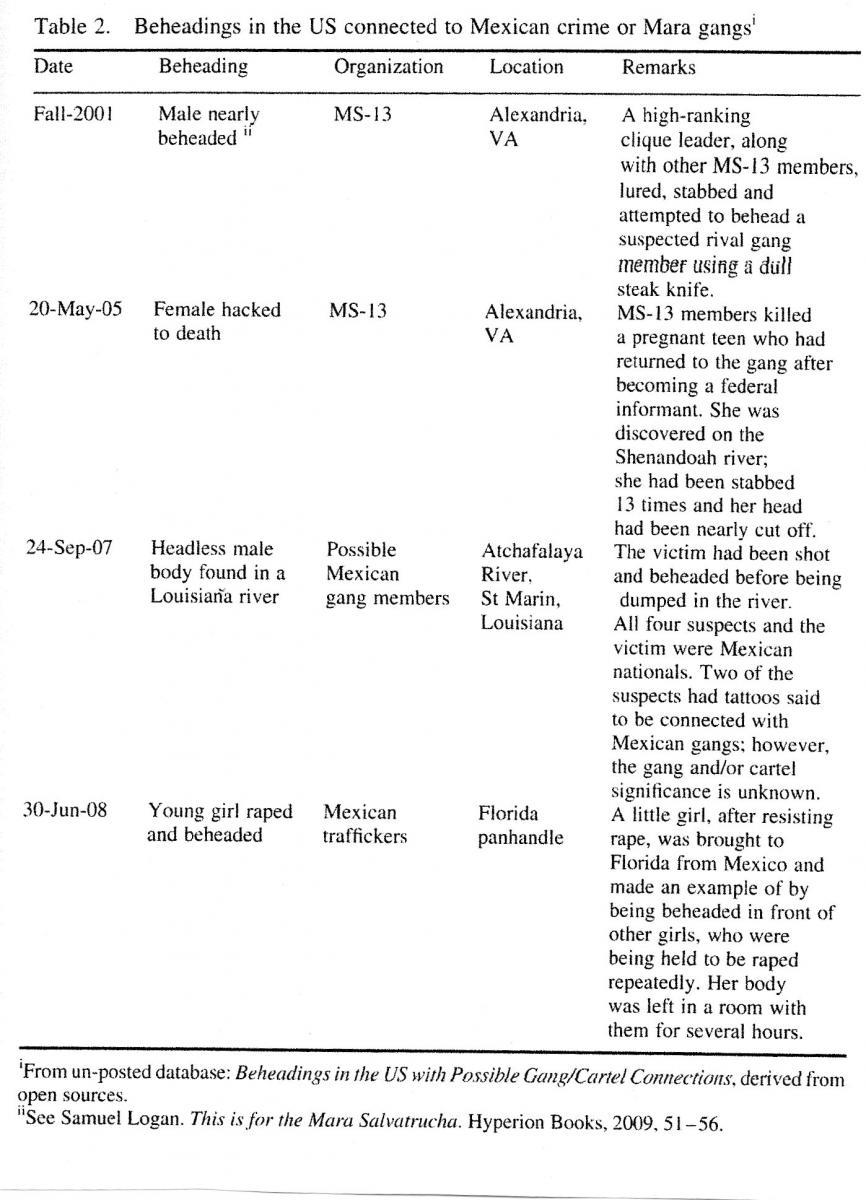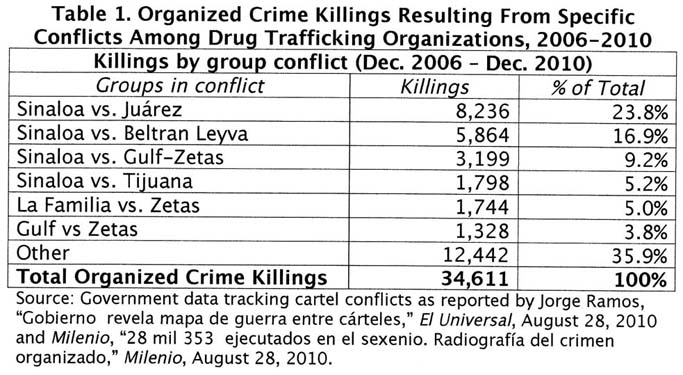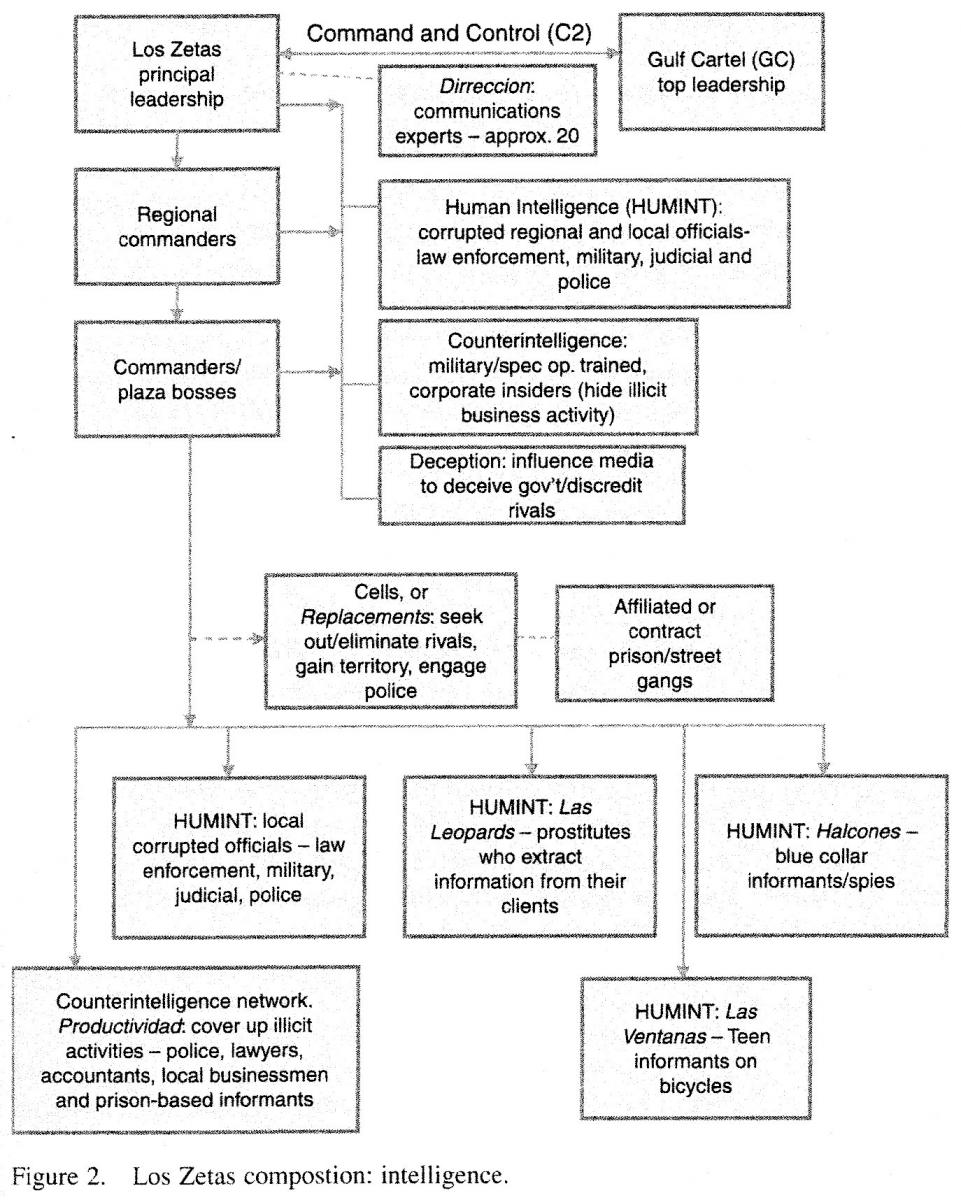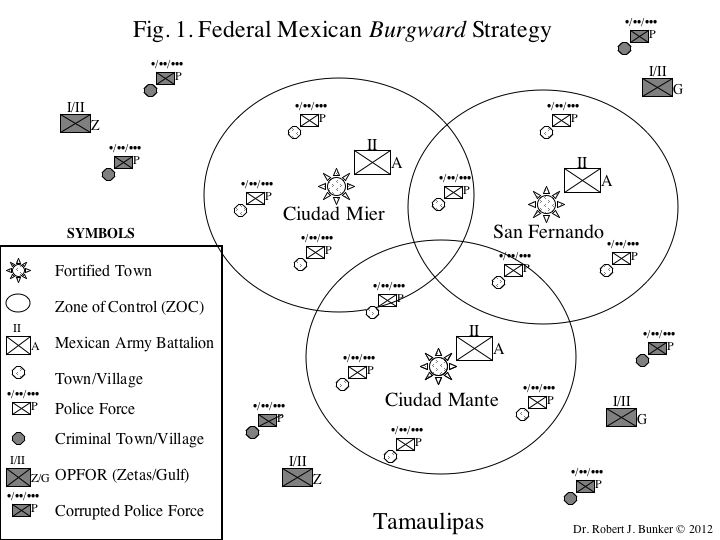The Effectiveness of Counterinsurgency Principles Against Criminal Insurgency
We have posted Michael L. Burgoyne's excellent thesis as a separate page due to its length, but I hope that readers will click through to the link and comment here to discuss his work. The thesis can also be downloaded as a PDF by clicking here. The opening portion is included below:
Abstract
Powerful criminal groups are developing into serious threats to nation states. Increasingly intense violence in Mexico is of particular interest to the United States. Coming on the heels of insurgency experiences in Iraq and Afghanistan, the United States is predisposed to apply its tested counterinsurgency doctrine to the problem. This study addresses the effectiveness of counterinsurgency principles against criminal insurgencies through a case study analysis of Colombia’s fight against the Medellin and Cali Cartels and Rio de Janeiro’s efforts against favela gangs. U.S. counterinsurgency doctrine proved to be highly effective against Rio’s gangs, however, the campaign against the Medellin and Cali Cartels indicates that an enemy focused approach may be more appropriate against a drug trafficking organization. The results of this study show that while much of U.S. counterinsurgency doctrine is applicable to criminal threats, several adjustments to campaign planning and threat analysis tools will be required to ensure its effectiveness against emerging criminal national security threats.
Mexico is currently engulfed by rampant violence that has taken over 40,000 lives since 2006.[1] Secretary of State Hillary Clinton referred to the drug fueled violence as an “insurgency,” while others have called it a “criminal insurgency.”[2] Criminal threats to state stability are becoming more common; Japanese Yakuza, Chinese Triads, Italian mafia, Russian mafia, and Colombian Bandas Criminales all represent dangerous evolving criminal organizations.[3] These unique apolitical security threats are not a new phenomenon, but they are rapidly developing into one of the most dangerous challenges in the globalized world. One of the greatest national security threats facing the United States today is the rapidly deteriorating security situation in Mexico where Drug Trafficking Organizations (DTO)[4] and enforcer gangs have ignited a countrywide war.[5]
Mexican criminal organizations have evolved into existential threats to the Mexican state and are now growing in the United States.[6] Initially transportation elements subordinate to the powerful Colombian cartels, Mexican DTOs capitalized on effective interdiction in the Caribbean and the demise of the Medellin and Cali Cartels to increase their control of the drug trade. This increase in criminal power coincided with an equally important political upheaval in Mexico.
The election of President Vicente Fox of the PAN party in 2000 effectively ended the one party system throwing long standing arrangements between PRI leaders and DTOs into chaos. Institutionalized corruption and government control of the illicit economy collapsed into violence as DTOs went to war with each other and the state to increase their control of territory and lucrative drug routes.[7] Following his election in 2006, Mexican President Felipe Calderón embarked upon a campaign against organized crime employing the “full force of the state in order to safeguard the liberty and security of its citizens.”[8] However, there remains no end to the violence in sight; 2010 was the most violent year yet with 15,273 homicides.[9] Calderon’s strategy has been applauded and criticized in both Mexico and the United States. Equally, the U.S. response to the crisis has been the subject of intense policy debate. Much of the frustration with the government response stems from confusion regarding the nature of the conflict.
Carl Von Clausewitz warns that “the first, the supreme, the most far reaching act of judgment that the statesman and commander have to make is to establish…the kind of war on which they are embarking; neither mistaking it for, nor trying to turn it into, something that is alien to its nature.”[10] Coming on the heels of the development of a robust counterinsurgency doctrine, many U.S. defense and law enforcement scholars have designated the Mexican conflict an insurgency.[11] Accordingly, counterinsurgency methodologies have been recommended as the proper response.[12] Conversely, other scholars like David Shirk and former head of the Drug Enforcement Administration Robert Bonner have called for a law enforcement response.[13] Far more than a mere academic semantic debate, the term insurgency impacts which agencies and methodologies government forces employ against the problem. These types of “wicked problems” are defined by “one’s idea for solving it.”[14] An incorrect diagnosis of the problem and its solution can have far reaching repercussions.
Whatever its nature, the United States has vital interests in Mexico. The United States has spent 90 billion dollars on border security since 2001[15] and spends over 15 billion dollars annually on drug control.[16] Mexico is the United States’ third largest trading partner with 393 billion dollars in trade in 2010.[17] The United States appropriated 1.5 billion dollars to support the Mérida Initiative, a multinational security agreement that focuses on operational support to law enforcement and institutional professionalization.[18] Given the importance of Mexico to the United States and the scope of the conflict, it is imperative that the U.S. strategy fit the problem.
Before the United States embarks on an expensive counterinsurgency campaign or advises foreign governments on their own campaigns, the efficacy of counterinsurgency principles against economic or criminal groups should be evaluated. Criminal insurgency is a unique type of threat. This study addresses the question to what extent counterinsurgency principles, as outlined in Field Manual 3-24 Counterinsurgency, are effective against criminal insurgencies; specifically, in Colombia’s fight against the Medellin and Cali Cartels and Rio de Janeiro’s efforts against favela gangs?
This study argues that the analysis of powerful criminal organizations using an insurgency framework is useful and that the Colombian cartels and Rio’s favela gangs can be appropriately described as criminal insurgencies. Several counterinsurgency principles listed in FM 3-24 were effective in both case studies including understanding the environment, intelligence driven operations, long term commitment, small unit empowerment, learning and adapting, and supporting the host nation. In addition, counterinsurgency methodologies, as found in U.S. doctrine, were highly effective against Rio’s favela gangs. However, the methodology employed in the case of the Medellin and Cali Cartels indicates that an enemy focused approach can be effective against a DTO. Furthermore, a DTO’s financial center of gravity seriously degrades the effectiveness of some of the principles found in COIN doctrine. Finally, several factors and techniques not specifically referenced in COIN doctrine can be critical in the case of a criminal insurgency, such as vetted units, anticorruption measures, financial targeting, divide and conquer approaches, and social and cultural root causes. This study will briefly review the evolution of the concept of criminal insurgency. The study will then examine the Medellin and Cali Cartels followed by Rio’s favela gangs. Each case will include a brief historical summary, an analysis using an insurgency lens, and an examination of the government response based on COIN principles. Finally, implications for security policy and recommendations will be provided.
This study is “policy-evaluative” and will examine the implicit theoretical assumption that criminal insurgencies can be defeated by current counterinsurgency doctrine.[19] Given the importance of the security threats involved, it is important to ask “will the policy produce the results that its proponents promise?”[20] Investigations such as RAND’s recent counterinsurgency report[21] and the Fishel-Manwaring SWORD model have scientifically evaluated the effectiveness of counterinsurgency strategies; however, current literature has not adequately addressed the use of counterinsurgency doctrine against criminal threats.[22]
This project uses a structured comparison of case studies with the goal of identifying the value of current counterinsurgency principles in the unique circumstances of a criminal insurgency.[23] Political scientist, Stephen Van Evra notes that when working with policy prescriptive studies, researchers should study cases whose background characteristics parallel the characteristics of the current or future policy problems.”[24] As such, two cases were selected that closely resemble current security concerns in Mexico: the Colombian defeat of the Cali and Medellin Cartels and the Brazilian fight against favela gangs.
Both of these cases were considered government victories because the threats to national security were defeated. This study assumes that both of these cases are government victories and focuses on the methodologies utilized. In Colombia, the powerful Medellin and Cali Cartels were dismantled leaving residual criminal groups. This study does not expand its time horizon to include efforts at community policing in Colombia after the fall of the Medellin and Cali Cartels. Expanding the case to include these initiatives would result in difficulty managing the distinction between criminal insurgency and crime as well as between counterinsurgency and normal governance. Furthermore, the security problems in Cali and Medellin after the fall of the major DTOs closely resemble the characteristics of the Rio case study.
The Rio case study, however, is a more defined phenomenon with less possibility of intervening variables arising from traditional insurgent groups like the FARC (Revolutionary Armed Forces of Colombia) and ELN (National Liberation Army) present in Colombia. In Rio, gangs that had successfully succeeded from government control were displaced and control was reestablished.[25] Since 2008, the government has cleared some 25 communities and reasserted state control over 280,000 citizens.[26]
To maintain a disciplined configurative approach the cases are evaluated using an insurgency analysis framework outlined by insurgency expert Bard O’Neill and the 13 principles and imperatives of counterinsurgency as found in Field Manual 3-24. One of the strengths of utilizing a case study methodology is that it serves “the heuristic purpose of inductively identifying additional variables and generating hypotheses.”[27] The detailed case study approach allows this study to go beyond O’Neill’s framework and the 13 principles to identify other factors that are important to the problem.
[1] BBC, “Mexico’s Drug Related Violence,” August 26, 2011, http://www.bbc.co.uk/news/world-latin-america-10681249. Also see Los Angeles Times, “Mexico Under Siege Website”, http://projects.latimes.com/mexico-drug-war/#/its-a-war.
[2] Hillary Clinton, Speech to Council on Foreign Relations, (Washington, DC, September 8, 2010), http://www.cfr.org/publication/22896/conversation_with_us_secretary_of_state_hillary_rodham_clinton.html; and John P. Sullivan and Adam Elkus, “State of Siege: Mexico’s Criminal Insurgency,” Small Wars Journal, 2008, www.swj.com.
[3] Max Manwaring, Gangs, Pseudo-Militaries, and other Modern Mercenaries, (Norman: Oklahoma University Press, 2010), 21-22.
[4] The term Drug Trafficking Organization of DTO will be used to denote organizations who have a primary business model based on drug trafficking. Although most DTOs also engage in extortion, protection, prostitution, and human trafficking this study will use DTO to differentiate between smuggling organizations and mafia type organizations.
[5] Robert J. Bunker, “El Imperativo Estratégico de Estados Unidos Debe Cambiar de Irak-Afganistán a México-Las Américas y la Estabilización de Europa,” Small Wars Journal, 2011.
[6] U.S. Department of Justice, National Drug Threat Assessment, (National Drug Intelligence Center, August, 2011), 8, http://www.justice.gov/ndic/pubs44/44849/44849p.pdf.
[7] George Grayson, Mexico: Narco Violence and a Failed State?,(New Brunswick: Transaction, 2010), 39-52.
[8] Gobierno Federal, “Modelo de Operación Estratégica y Táctica Frente a la Delincuencia Organizada,” April 30, 2009, http://www.pgr.gob.mx/prensa/documentos.asp.
[9] Sara Miller Llana, “Mexico drug war death toll up 60 percent in 2010. Why?” Christian Science Monitor, January 13, 2011.
[10] Carl Von Clausewitz, On War, trans Michael Howard and Peter Paret, (Princeton, Princeton University Press, 1997), 88.
[11] Matthew D. LaPlante, “Army official suggests U.S. troops might be needed in Mexico,” Salt Lake Tribune, March 22, 2011; John P. Sullivan and Adam Elkus, “State of Siege: Mexico’s Criminal Insurgency,” Small Wars Journal, 2008; Sullivan and Elkus “Cartel vs. Cartel: Mexico’s Criminal Insurgency,” Small Wars Journal, 2009; Sullivan and Robert Bunker, “Cartel Evolution Revisited,” Small Wars and Insurgencies 21, (March 23, 2010).
[12] Bob Killebrew and Jennifer Bernal, Crime Wars: Gangs, Cartels and U.S. National Security, (Washington, DC: Center for a New American Security, 2010). Also see Representative Connie Mack, Prepared Remarks before House Foreign Affairs Committee, “Merida Part Two: Insurgency and Terrorism in Mexico,” October 4, 2011.
[13] Woodrow Wilson Center Mexico Institute Presentation, Shared Responsibility, (Washington, DC, October 22, 2010). Robert Bonner, “The New Cocaine Cowboys,” Foreign Affairs 89, (2010).
[14] Horst W.J. Rittel and Melvin M. Webber, “Dilemmas in a General Theory of Planning,” Policy Sciences 4, (1973), 161.
[15] Martha Mendoza, “$90b spent on border security, with mixed results,” Associated Press, June 26, 2011.
[16] Executive Office of the President, Office of National Drug Control Policy, National Drug Control Strategy FY 2011 Budget Summary, (Washington, DC: 2010). http://www.whitehouse.gov/sites/default/files/ondcp/policy-and-research/fy11budget.pdf.
[17] U.S. Census Bureau, Foreign Trade Statistics 2010, http://www.census.gov/foreign-trade/statistics/highlights/top/top1012yr.html,
[18] U.S. Department of State, Bureau of Public Affairs, The Merida Initiative: Expanding the U.S./Mexico Partnership, March 3, 2011. http://www.state.gov/r/pa/plrmo/157797.htm,
[19] Stephen Van Evra, Guide to Methods for Students of Political Science, (Ithica: Cornell University Press, 1997), 91.
[20] Ibid.
[21] Christopher Paul, Colin P. Clarke, and Beth Grill, Victory has a Thousand Fathers, (Santa Monica: RAND, 2010).
[22] John T. Fishel, and Max G. Manwaring, Uncomfortable Wars Revisited, (Norman:University of Oklahoma Press, 2006) and “The SWORD Model of Counterinsurgency: A Summary and Update” Small Wars Journal, 2008 also “Insurgency and Counter-Insurgency: Toward a New Analytical Approach,” Small Wars and Insurgencies 3, (Winter, 1992), 272.
[23] Alexander L. George and Andrew Bennett, Case Studies and Theory Development in the Social Sciences, (Cambridge: MIT Press, 2005), 75.
[24] Van Evra, 85.
[25] Security operations in Rio are ongoing. This study focused on favelas that had already been occupied under the UPP program.
[26] UPP Website.
[27] George and Bennett, 45.




